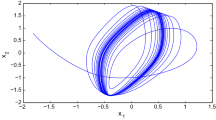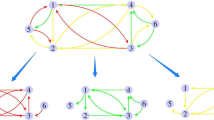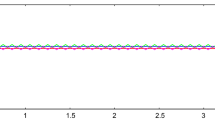Abstract
This paper investigates finite-time synchronization for fuzzy Cohen–Grossberg neural networks (FCGNNs) with mixed delays and discontinuous activations via state-feedback control. The features of FCGNNs, discrete time delays, distributed delays and discontinuous activations are taken into account which makes our networks more general and practical in comparison with the most existing Cohen–Grossberg neural networks. Two switching state-feedback controllers designed for the implement of finite-time synchronization can be used to effectively overcome the limitations of the traditional continuous linear feedback controllers. Different from previous work, graph theory and Lyapunov method are used to study finite-time synchronization of FCGNNs for the first time in this paper, then some sufficient criteria are obtained to guarantee the finite-time synchronization of FCGNNs. In particular, it is worth noting that the settling time for finite-time synchronization is closely related to the topological structure of FCNNs. Finally, two numerical examples are given to verify the feasibility and effectiveness of the theoretical results.









Similar content being viewed by others
References
Cohen M, Grossberg S (1983) Absolute stability and global pattern formation and parallel memory storage by competitive neural networks. IEEE Trans Syst Man Cybern 13:815–821
Yang T, Yang L, Wu C, Chua L (1996) Fuzzy Cellular Neural Networks: theory. In: Proceedings of IEEE international workshop on cellular neural networks and applications, pp 181–186
Yang W, Yu W, Cao J, Alsaadi F, Hayat T (2018) Global exponential stability and lag synchronization for delayed memristive fuzzy Cohen–Grossberg BAM neural networks with impulses. Neural Netw 98:122–153
Xu C, Li P (2017) \(\rm p \)th moment exponential stability of stochastic fuzzy Cohen–Grossberg neural networks with discrete and distributed delays. Nonlinear Anal Model Control 22:531–544
Wu Y, Zhu J, Li W (2019) Intermittent discrete observation control for synchronization of stochastic neural networks IEEE Trans Cybern (regular paper) to be published. https://doi.org/10.1109/TCYB.2019.2930579
Wu H, Feng Y, Tu Z, Zhong J, Zeng Q (2018) Exponential synchronization of memristive neural networks with time delays. Neurocomputing 297:1–7
Zhang Z, Ren L (2019) New sufficient conditions on global asymptotic synchronization of inertial delayed neural networks by using integrating inequality techniques. Nonlinear Dyn 95:905–917
Shen H, Jiao S, Cao J, Huang T (2019) An improved result on sampled-data synchronization of Markov jump delayed neural networks. IEEE Trans Syst Man Cybern Syst. https://doi.org/10.1109/TSMC.2019.2931533
Shen H, Huang Z, Cao J, Park J (2019) Exponential \(H_{\infty }\) filtering for continuous-time switched neural networks under persistent dwell-time switching regularity. IEEE T Cybern. https://doi.org/10.1109/TCYB.2019.2901867
Shen H, Huo S, Yan H, Park J, Sreeram V (2019) Distributed dissipative state estimation for Markov jump genetic regulatory networks subject to round-robin scheduling. IEEE Trans Neural Netw Learn Syst. https://doi.org/10.1109/TSMC.2019.2931533
Pratap A, Raja R, Cao J, Rajchakit G, Alsaadi F (2018) Further synchronization in finite time analysis for time-varying delayed fractional order memristive competitive neural networks with leakage delay. Neurocomputing 317:110–126
Selvaraja P, Sakthivel R, Kwona O (2018) Finite-time synchronization of stochastic coupled neural networks subject to Markovian switching and input saturation. Neural Netw 105:154–165
Lu W, Chen T (2008) Almost periodic dynamics of a class of delayed neural networks with discontinuous activations. Neural Comput 20:1065–1090
Banerjee S, Verghese G (2001) Nonlinear phenomena in power electronics: attractors, bifurcations, chaos, and nonlinear control. Wiley, New York
Liberzon D (2003) Switching in systems and control, in systems and control: foundations & applications. Birkh\(\ddot{a}\)ser, Boston
Forti M, Nistri P (2003) Global convergence of neural networks with discontinuous neuron activations. IEEE Trans Circuits Syst I-Regul Pap 50:1421–1435
Chen X, Song Q (2010) Global exponential stability of the periodic solution of delayed Cohen–Grossberg neural networks with discontinuous activations. Neurocomputing 73:3097–3104
Li S, Lv C, Ding X (2020) Synchronization of stochastic hybrid coupled systems with multi-weights and mixed delays via aperiodically adaptive intermittent control. Nonlinear Anal Hybrid Syst 35:100819
Wang P, Feng J, Su H (2019) Stabilization of stochastic delayed networks with Markovian switching and hybrid nonlinear coupling via aperiodically intermittent control. Nonlinear Anal Hybrid Syst 32:115–130
Xu Y, Zhou H, Li W (2018) Stabilisation of stochastic delayed systems with levy noise on networks via periodically intermittent control. J Control Int. https://doi.org/10.1080/00207179.2018.1479538
Wang M (XXXX) Aperiodically intermittent control for exponential bipartite synchronization of delayed signed networks with multi-links. Chaos https://doi.org/10.1063/1.5126464
ArthiaJu G, Parkb H, Suganya K (2019) Controllability of fractional order damped dynamical systems with distributed delays. Math Comput Simul 165:74–91
Wang P, Sun Z, Su H, Fan M (2019) Stability analysis for stochastic complex-valued delayed networks with multiple nonlinear links and impulsive effects. Nonlinear Dyn 97(4):1959–1976
Wang M, Li W (2019) Stability of random impulsive coupled systems on networks with Markovian switching. Stoch Anal Appl 37(6):1107–1132
Chen H, Shi P, Lim C (2017) Exponential synchronization for markovian stochastic coupled neural networks of neutral-type via adaptive feedback control. IEEE Trans Neural Netw Learn Syst 28:1618–1632
Wang D, Mu C (2017) A novel neural optimal control framework with nonlinear dynamics: closed-loop stability and simulation verification. Neurocomputing 266:353–360
Li S, Su H, Ding X (2018) Synchronized stationary distribution of hybrid stochastic coupled systems with applications to coupled oscillators and a Chua’s circuits network. J Frankl Inst Eng Appl Math 355(17):8743–8765
Liu X, Cao J, Yu W (2012) Filippov systems and quasi-synchronization control for switched networks. Chaos 22:033110
Li M, Shuai Z (2010) Global-stability problem for coupled systems of differential equations on networks. J Differ Equ 248:1–20
Liu Y, Yu P, Chu D, Su H (2019) Stationary distribution of stochastic multi-group models with dispersal and telegraph noise. Nonlinear Anal Hybrid Syst 33:93–103
Xu Y, Chu C, Li W (2018) Quantized feedback control scheme on coupled systems with time delay and distributed delay: a finite-time inner synchronization analysis. Appl Math Comput 337:315–328
Forti M, Grazzini M, Nistri P, Pancioni L (2006) Generalized Lyapunov approach for convergence of neural networks with discontinuous or non-Lipschitz activations. Physica D 214:88–99
Duan L, Wei H, Huang L (2019) Finite-time synchronization of delayed fuzzy cellular neural networks with discontinuous activations. Fuzzy Sets Syst 361:56–70
Wang H, Zhang X, Wang X, Zhu X (2012) Finite time chaos control for a class of chaotic systems with input nonlinearities via TSM scheme. Nonlinear Dyn 69:1941–1947
Hardy G, Littlewood J, Polya G (1988) Inequalities. Cambridge University Press, London
Park M, Kwon O, Park J, Lee S, Cha E (2013) On synchronization criterion for coupled discrete-time neural networks with interval time-varying delays. Neurocomputing 99:188–196
Song Q (2009) Synchronization analysis of coupled connected neural networks with mixed time delays. Neurocomputing 72:3907–3914
Zhang H, Gong D, Chen B, Liu Z (2013) Synchronization for coupled neural networks with interval delay: a novel augmented Lyapunov-Krasovskii functional method. IEEE Trans Neural Netw Learn Syst 24:58–70
Wu Y, Zhuang S, Li W (2019) Periodically intermittent discrete observation control for synchronization of the general stochastic complex network. Automatica 110:108591
Zhou H, Zhang Y, Li W (2019) Synchronization of stochastic Levy noise systems on a multi-weights network and its applications of Chua’s circuits. IEEE Trans Circuits Syst I-Regul Pap 66:2709–2722
Zhang X, Feng G, Sun Y (2012) Finite-time stabilization by state feedback comtrol for a class of time-varying nonlinear systems. Automatica 48:499–504
Muhammadhaji A, Abdurahman A (2019) General decay synchronization for fuzzy cellular neural networks with time-varying delays. Int J Nonlinear Sci Numer Simul 20(5):551–560
Wang G, Yin Q, Shen Y (2013) Exponential synchronization of coupled fuzzy neural networks with disturbances and mixed time-delays. Neurocomputing 106:77–85
Pu H, Liu Y, Jiang H (2015) Exponential synchronization for fuzzy cellular neural networks with time-varying delays and nonlinear impulsive effects. Cognit Neurodyn 9(4):437–446
Xu Y, Li Q, Li W (2019) Periodically intermittent discrete observation control for synchronization of fractional-order coupled systems. Commun Nonlinear Sci Numer Simul 74:219–235
Liu Y, Xu H, Li W (2019) Intermittent control to stationary distribution and exponential stability for hybrid multi-stochastic-weight coupled networks based on aperiodicity. J Frankl Inst Eng Appl Math 356(13):7263–7289
Faydasicok O, Arik S (2012) Further analysis of global robust stability of neural networks with multiple time delays. J Frankl Inst Eng Appl Math 349:813–825
Faydasicok O, Arik S (2013) A new robust stability criterion for dynamical neural networks with multiple time delays. Neurocomputing 99:290–297
Faydasicok O, Arik S (2013) A new upper bound for the norm of interval matrices with application to robust stability analysis of delayed neural networks. Neural Netw 44:64–71
Zhou H, Li W (2019) Synchronisation of stochastic-coupled intermittent control systems with delays and L\(\acute{e}\)vy noise on networks without strong connectedness. IET Control Theory Appl 13:36–49
Funding
This work is supported by the Fundamental Research Funds for the Central Universities (No. 2572016CB08).
Author information
Authors and Affiliations
Corresponding author
Ethics declarations
Conflict of Interest
The authors declare that they have no conflict of interest.
Additional information
Publisher's Note
Springer Nature remains neutral with regard to jurisdictional claims in published maps and institutional affiliations.
Appendix
Appendix
The values of elements in matrixes \((\alpha _{kh})_{20\times 20}\), \((\beta _{kh})_{20\times 20}\), \((H_{kh})_{20\times 20}\) and \((T_{kh})_{20\times 20}\) are shown as follows, while the elements unmentioned are set as 0 (Tables 2, 3):
Rights and permissions
About this article
Cite this article
Xu, D., Xu, C. & Liu, M. Graph-Theoretic Approach to Finite-Time Synchronization for Fuzzy Cohen–Grossberg Neural Networks with Mixed Delays and Discontinuous Activations. Neural Process Lett 52, 905–933 (2020). https://doi.org/10.1007/s11063-020-10237-4
Published:
Issue Date:
DOI: https://doi.org/10.1007/s11063-020-10237-4




